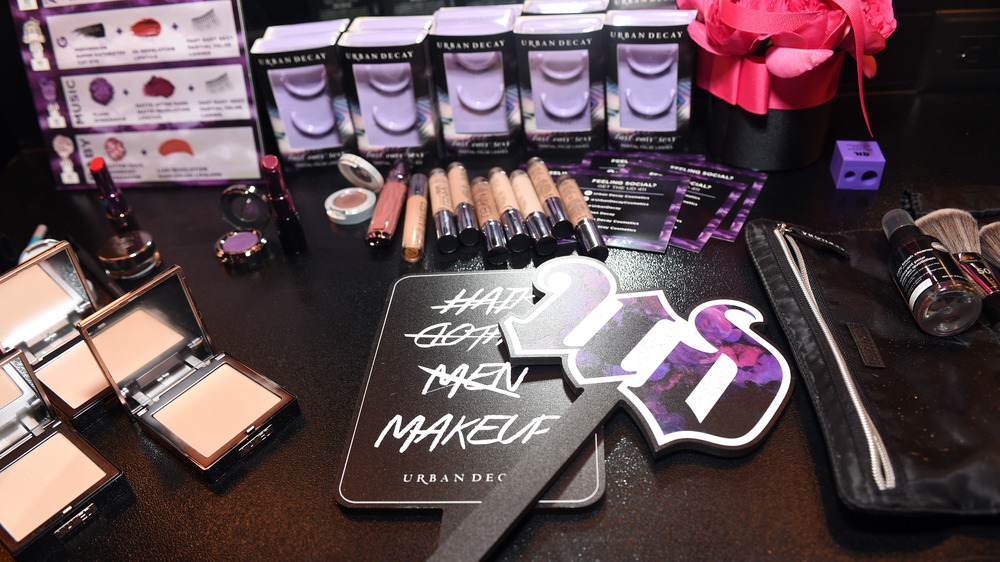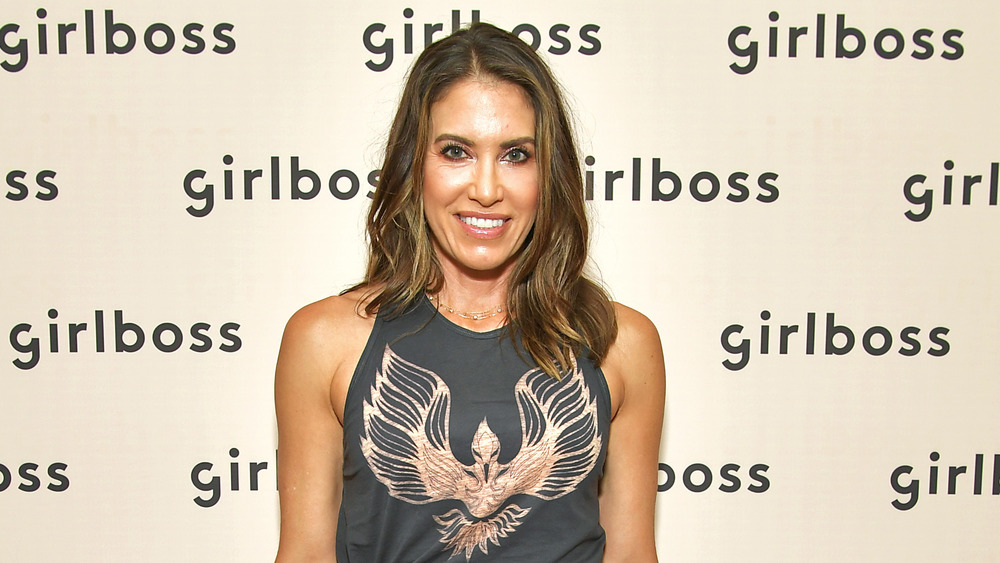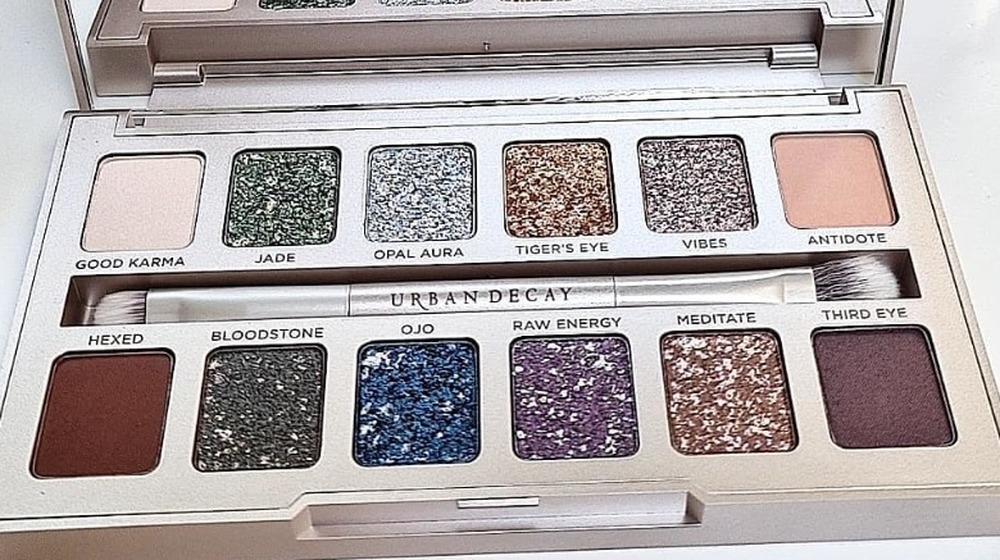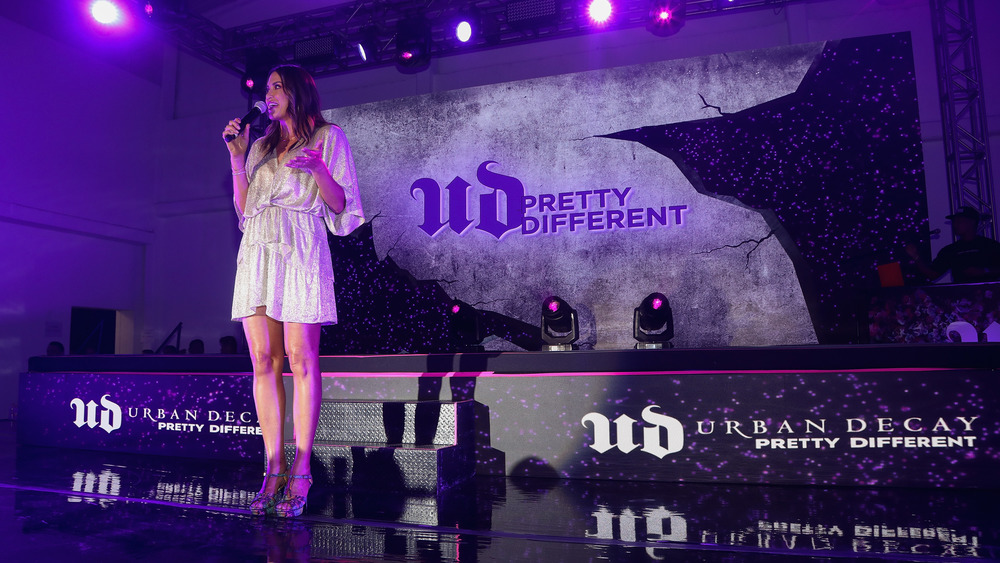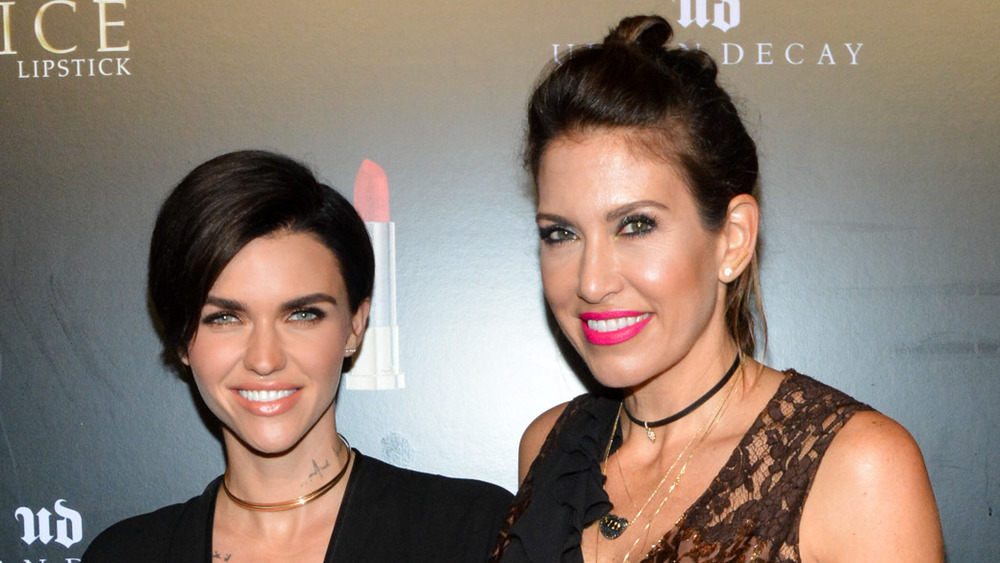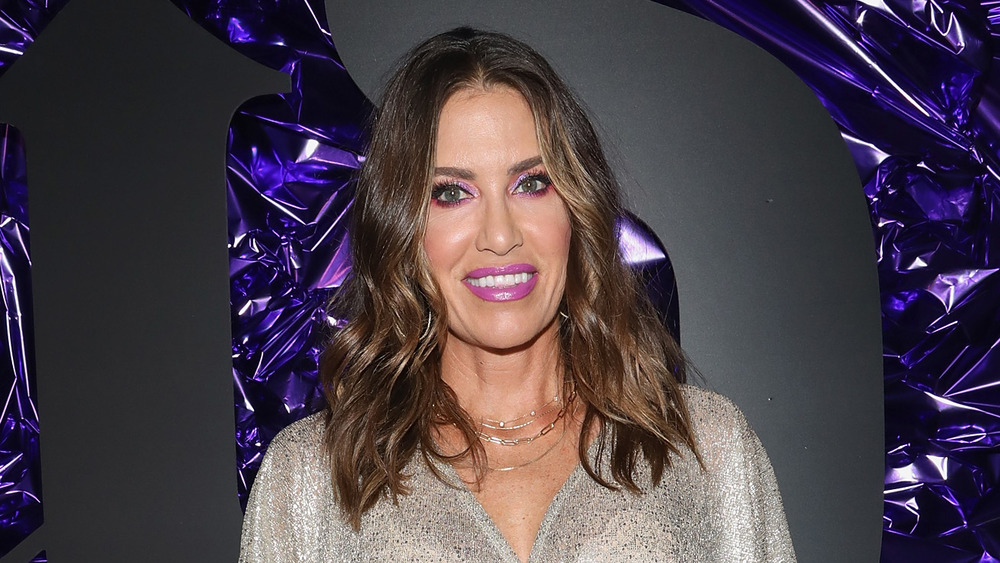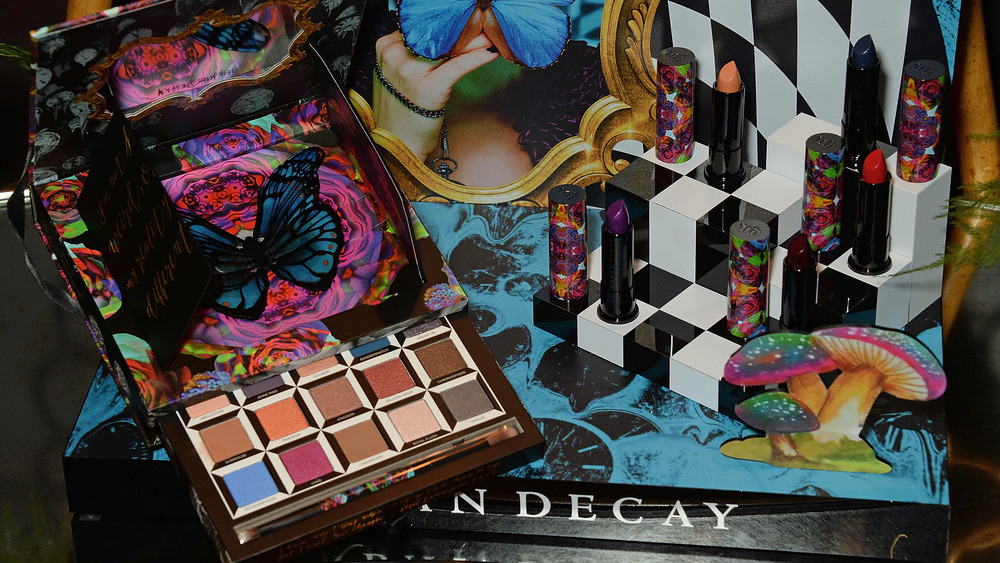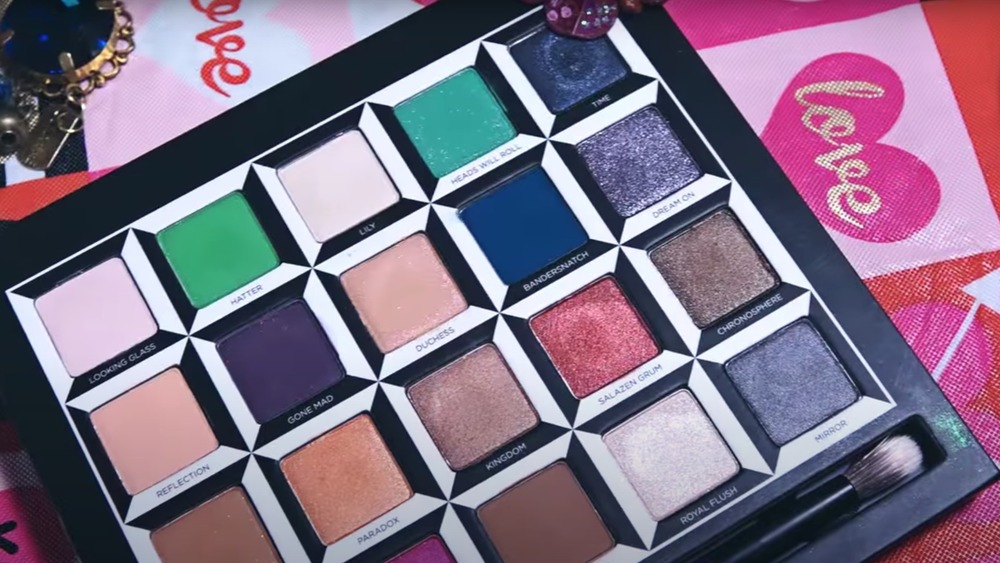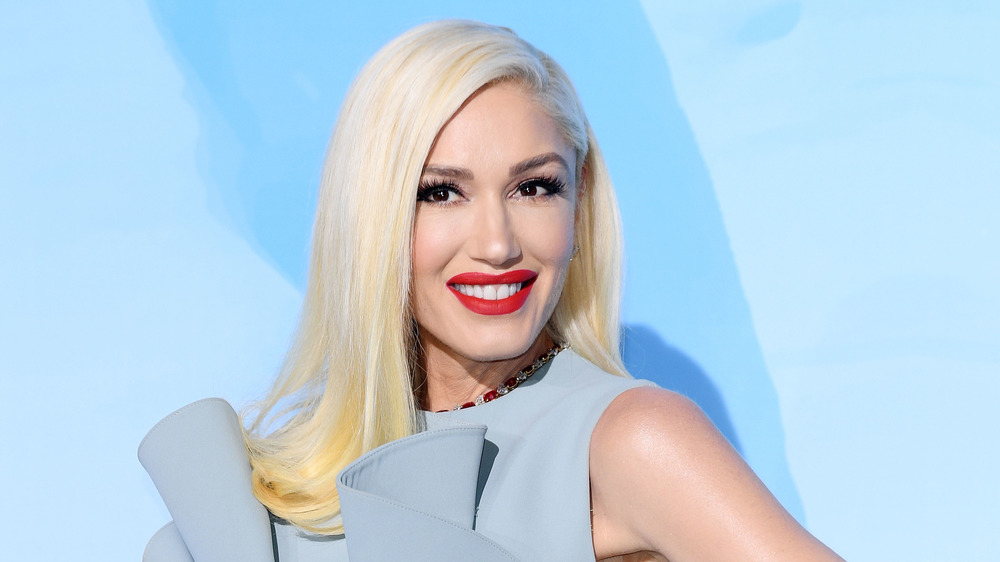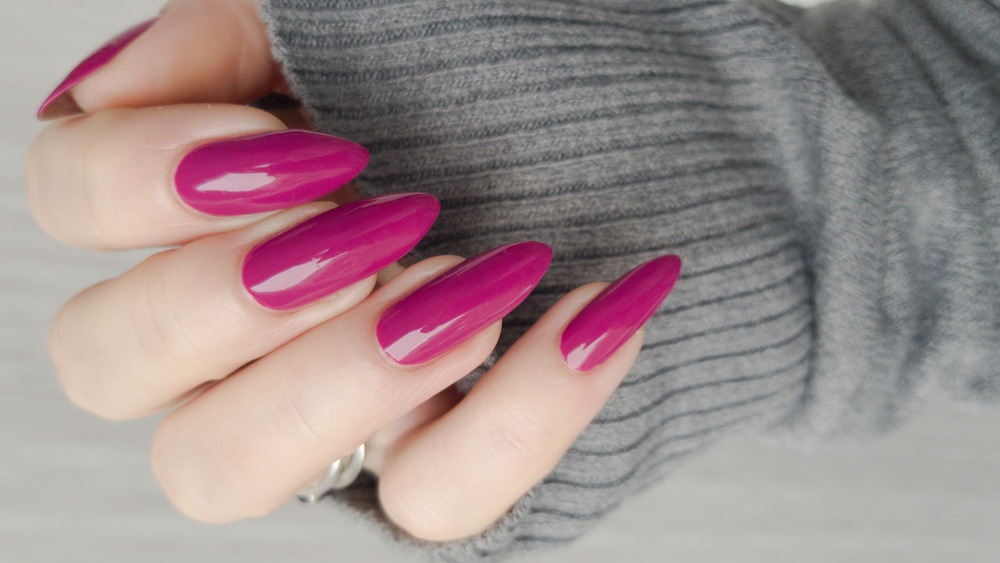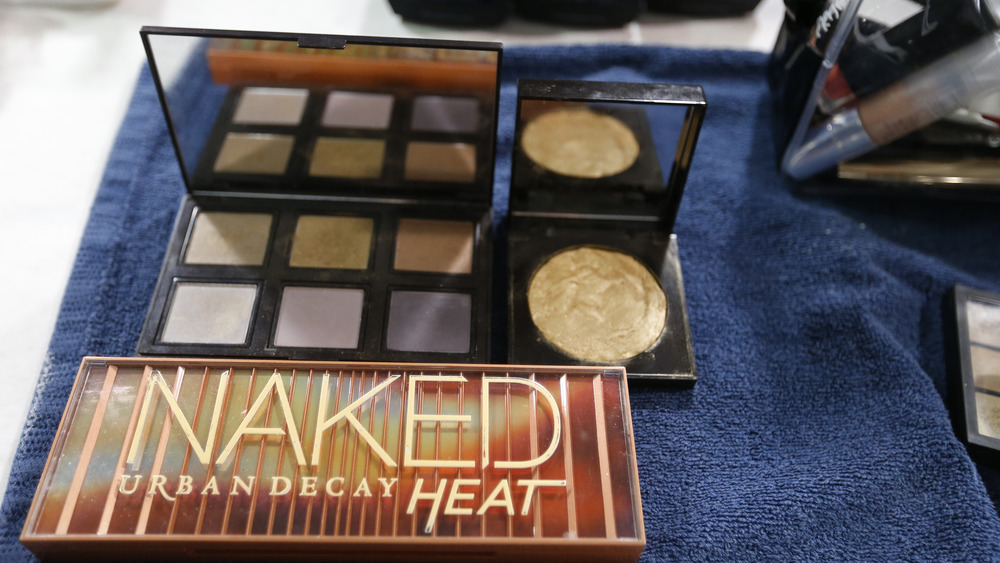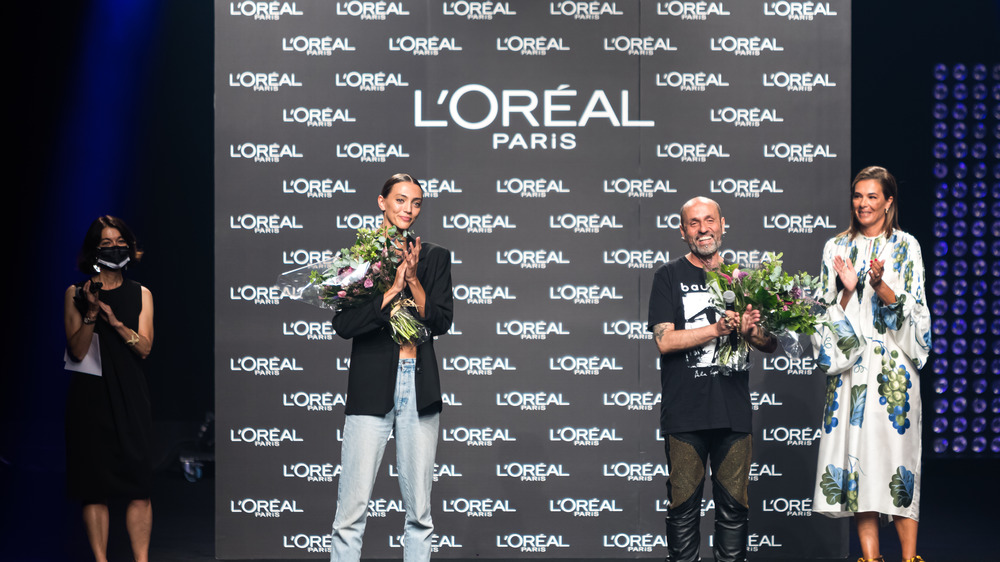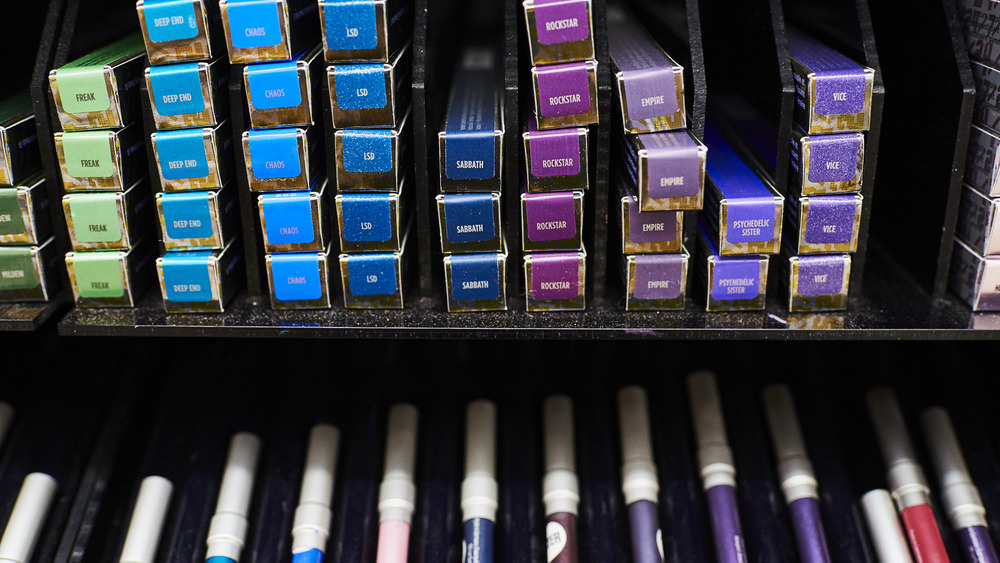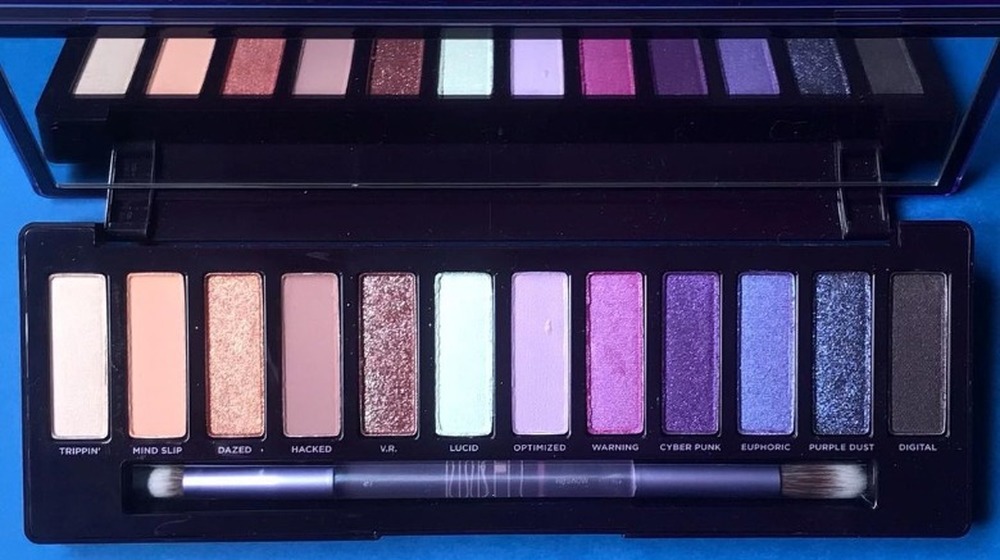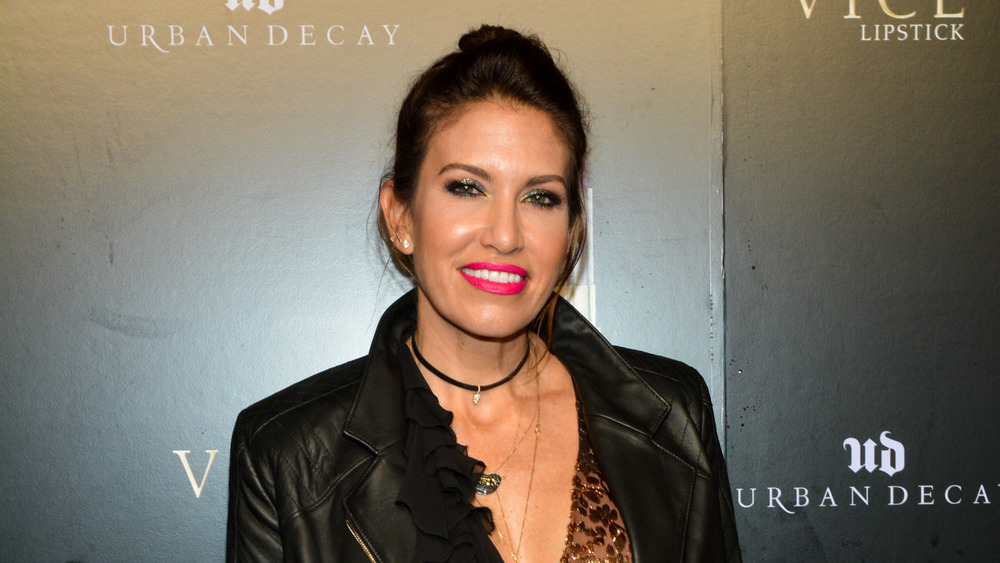The Untold Truth Of Urban Decay
Urban Decay makeup is a staple at Sephoras and Ultas around the world, thanks to the makeup company's iconic products like the Naked eyeshadow palette and their bomb eyeshadow primer. The edgy makeup brand never met a bold color or sparkling shimmer that it didn't like, which is why you can always count on Urban Decay to stand apart from the crowd. Beloved by millions of ardent makeup fans, Urban Decay is what we turn to when we're heading out to the underground club or spending the day in the city — and we want to look good doing it.
If you're someone who's been wearing Urban Decay since it launched in the '90s, chances are you've seen the brand grow throughout the years. And fortunately for fans, Urban Decay has only continued to lean into its signature bold look, keeping the jewel-toned eyeliners and gorgeous red lipsticks on the shelves for all of us to fawn over.
Curious to know how Urban Decay came to be, as well as the women behind the brand? Read on to discover the untold truth of Urban Decay.
This is how Urban Decay's founder got her start in makeup
One of the cool things you might not know about Urban Decay is that it was founded by women! Most notably, Chief Creative Officer Wende Zomnir came up with the idea of Urban Decay in the '90s, though she got her start in the makeup business behind the counter of a Monning's department store. "My co-workers were career counter ladies in their 50s and 60s," she recalled in an interview with The Cut. "I learned so much from them about products, why people buy, and about life in general."
While the demographic she served at Monning's was vastly different than that of Urban Decay, Zomnir still shared her passion for bold makeup. "Our customers were older, so it was more of a skin-care play, but I always managed to sell them some makeup because that was what I loved," she continued. "There was one dark purple eye shadow in the line, and I wore it every single day." Thus, the seeds were planted.
The co-founders of Urban Decay were tired of boring makeup
After working for a while in the advertising industry and not really enjoying it, Urban Decay's Wende Zomnir realized that she wanted to be an entrepreneur. But it wasn't until she met her future business partner and co-founder of Urban Decay that things fell into place. "When I met Sandy Lerner ... everything changed," she explained in an interview with Cosmopolitan. "She was like, 'You know, there's just no good-quality makeup available in different crazy colors.'" At the time, everything available was tame, especially compared to what's available today — and the pair were bored of the options from makeup companies like Maybelline and CoverGirl.
Determined to seize the opportunity in front of them, Zomnir and Lerner got to work. "After that, the wheels started turning, and I thought, You know, we really could do this. We really could start a makeup brand," Zomnir continued. "We were shipping product by January 1996." And, thus, Urban Decay was born.
For a while, the duo used Zomnir's Laguna Beach home as HQ, until their hustle grew too big for its britches.
This is the story of Urban Decay's famous name
So what's the story behind the name Urban Decay, anyway? It certainly isn't like most of the other makeup brands out there even today, since most are either named after a person or appeal to some sort of abstract esthetic concept.
As Wende Zomnir tells it, she and her business partner knew that they wanted the name to stand out from the "hyper-feminine and pink" makeup landscape of the era. And while they agreed on including the word "urban," the "decay" portion came about when Zomnir was out and about. "While I was in New York, I noticed how beautiful this crumbling brick wall was," she revealed in a chat with Cult Beauty. "It had so much depth and history, yet it wasn't conventionally perfect, or shiny or slick. And I thought, that's what we are saying with the name: that something can be really imperfect, and yet incredibly beautiful at the same time." We couldn't have come up with better if we tried.
Urban Decay took a "grassroots" approach when it started
Wende Zomnir of Urban Decay developed and perfected a serious hustle — not only was the makeup landscape vastly different in the mid-'90s than it is today, so, too, was the way you got your brand noticed. "I would show up at music festivals to track down Shirley Manson and Gwen Stefani and get them to try the products," she revealed in an interview with Bloomberg. "It was guerrilla, grass roots."
Additionally, back then you got makeup news from magazines, so Zomnir knew she had to get their attention. "I would cold call [editors] and say, 'I have a new cosmetics line, can I come meet with you?'" she told Forbes. "I made press kits out of hardware store supplies and ran around New York trying to pitch people my brand." Our girl was fearless!
And since this was long before makeup tutorials on YouTube and Instagram influencers, Zomnir took the analog route to spread the word; she sent Urban Decay makeup to popular women in New York City. "That was kind of how we tried to seed the cool factor of the brand," she added.
Wende Zomnir's ad agency background helped Urban Decay grow
Once Urban Decay was off the ground and running, Wende Zomnir knew that the next step was to get into department stores. To that end, she swiped a friend's contact list at Nordstrom and began soliciting makeup buyers. Eventually, that landed Zomnir her shot. "I think that one of the things that helped me so much was that when I walked into that first meeting with Nordstrom, I had a pitch," she revealed in a chat with Cosmopolitan. "I had learned from my ad agency days how to be professional." Even if Zomnir didn't like the ad business, it certainly primed her for the business world.
It was with that confidence and poise that Zomnir brought Urban Decay to the next level. "Even though I looked edgy and had a different perspective, and my brand was really different and quirky compared to what was out there at the time, I knew how to go in and sell the product, sell myself, and make them believe in me," she added.
This was Urban Decay's "first big hit"
It was in 1998, several years after the company was founded, that Urban Decay really began to have a presence in the market. That's thanks to their Midnight Cowboy eye shadow, which was a runaway success for the brand. "The edgy name was part of the secret sauce — it was naughty," Wende Zomnir shared with Bloomberg. "That was our first big hit."
In addition to the name of the product being important, so, too, was the makeup itself. That's because Urban Decay "shot it through with pieces of glitter," which, at the time, was a completely new thing. "It appealed to that kind of edgy girl, but it also had a broader appeal to the woman who just wanted to dip her toe into the water of being edgy," Zomnir told Forbes. "That was where we started to discover how to bridge the gap between being a niche brand and being a brand with a broader appeal." They really were light years ahead of the curve!
This is the Urban Decay product that changed the game
While Urban Decay's Midnight Cowboy eyeshadow was the brand's "first big hit," that was just the beginning. After years of continued and steady success, in 2010, Urban Decay launched a product that totally changed the game. As Wende Zomnir recalled, this was also a time when huge makeup launches weren't quite a thing yet. "What really exploded our brand into everyone's kind of consciousness in the makeup world was the Alice in Wonderland palette," she revealed in an interview with Cosmopolitan. "It sold out before it ever hit the shelves."
Of course, that meant that customers were dying to get ahold of one of the palettes, which created insane demand at department stores and makeup shops. "The employees at the stores didn't know what to do," she continued. "People were coming in and asking for it, so they were selling it out of the back room."
The one downside to such success was that Urban Decay couldn't use any of the amazing displays that were made for the Alice in Wonderland palette's debut. Talk about a good problem to have!
Urban Decay's first celeb collab was with Gwen Stefani
Urban Decay needed just the right celeb collaboration to make a dent in the market. When you think of '90s fashion icons with an edge, who comes to mind? If you said Gwen Stefani — whose band No Doubt hasn't released an album since 2012 — we can't think of a better answer. And speaking of that edge, Stefani and Urban Decay have a relationship that goes back for decades.
Given Wende Zomnir's "guerrilla grass roots" marketing strategy early on, it's not surprising that she sought out Stefani at music festivals. Obviously, the "Don't Speak" singer is fond of Urban Decay as well, as she was the first celebrity to curate a collaboration with the brand, as noted by Allure. We can imagine that helped sales grow!
Stefani would go on to create another collaboration with Urban Decay in 2015, according to the brand's Instagram page. "I've been a fan of Gwen's since we met in the early days of No Doubt and I'm so excited to announce our collaboration," Zomnir wrote in the caption. "We've created some amazing makeup together and I can't wait to share it with you."
Urban Decay had die-hard fans early on
If you thought that you were a super fan of Urban Decay, there's one other person who might be more worthy of the title than you. Even if your entire makeup bag is Urban Decay and Urban Decay only, chances are you don't love the brand as much as one uber fan.
As noted by Allure, back in the '90s (which arguably were some wild times, we were there), one person was so committed to Urban Decay that she painted her entire car in one of the brand's nail polishes. As the story goes, the fan contacted Urban Decay and asked to get literally gallons of the Asphyxia shade; the makeup company was more than happy to fulfill the request and even sent the fan actual car paint in the shade in question. So, if you ever see a Ford Explorer tooling around in SoCal with the license plate "ASPHYXIA," then you've found this die-hard fan. And wouldn't it be impressive to have the car still running all these years later?!
Urban Decay's Naked palette changed the game again in 2010
If you're a fan of Urban Decay makeup — even if you didn't paint your car to prove it — then you're probably a fan of one of Urban Decay's biggest and most successful products: their iconic Naked eyeshadow palettes. It's a bit ironic, since Urban Decay set out to upend the market with bold, edgy colors, but when something works, it works.
Wende Zomnir knew from the get-go that the OG Naked palette would be "a top-selling palette," but she didn't realize how hugely popular it would become. "The idea for it came from my product development director guy and I," she explained to StyleCaster. "We were sitting around and were like well, if you had to take four eyeshadow shades to a desert island, what would those eyeshadow shades be?"
Since the inception of the Naked palette, the sub-brand is so insanely in demand that, globally, a Naked-branded product sells every seven seconds (via Allure). There are now at least 29 such items, and 11 or more counterfeits have been identified. Impressive.
This makeup giant purchased Urban Decay in 2012
Oftentimes, the true marker of a successful brand is whether it gets offers from industry juggernauts to purchase the company — this just so happened to Urban Decay. The edgy makeup brand celebrated a huge milestone when it was acquired by a global cosmetics brand, says Wende Zomnir. "We got bought by L'Oréal in 2012," she explained in an interview with Bloomberg. "To take the brand globally, you really need a partner with the infrastructure and ability to do that." She added that since the acquisition, Urban Decay is found in 28 countries, with approximately $475 million in sales. That is light years beyond coming up with makeup colors in your house and hustling at music festivals.
Of course, there have been growing pains, something that Zomnir has been forthcoming about. "It's always tricky, because change is never easy, and power and control are difficult things to balance," she told The Newsette. But from the looks of things, Urban Decay is doing just fine.
Urban Decay is the bridge between old school and new school beauty
Urban Decay's Wende Zomnir recognizes the impact that the internet has had on the way we perceive, create, and share beauty. After all, makeup tutorials alone have broadened who can and can't wear makeup, as well as how it's worn. "The great thing about beauty is that it doesn't matter your shape, size or color," she shared in a chat with Forbes. "People like [makeup artist and beauty influencer] Patrick Starrr have shown us through makeup that you can say 'I'm just a regular looking guy, and I can also be the most glamorous woman in the world as well.'" We are so here for this!
Given that Urban Decay was born in the pre-internet world but has stayed on top of trends, this puts the brand in a unique position in the beauty industry, according to Zomnir. "I feel like Urban Decay has really been the bridge between the old world, and the new world of beauty," she continued. We couldn't agree more.
Wende Zomnir wants to make Urban Decay more sustainable going forward
One of the fun aspects of Urban Decay, other than the high-quality makeup and clever names, is the packaging of their products. Oftentimes the makeup arrives in colorful, shimmering containers with flourishes that make the outside just as exciting as the inside.
As we've become more aware of our impact on the planet, however, many of us might think twice about packaging if it's not sustainable. Well, fear not, Urban Decay fans, as Wende Zomnir is doing her part. "I'm working to make sure we merchandise products in a really beautiful way, and have really great displays that aren't all plastic, or if they are, that they have a multi-use function and can be reused over and over," she told The Newsette, adding that she's striving for "less waste, more recycling and reusing."
Zomnir knows that producing packaging that not only looks good but that is also environmentally friendly is going to be a challenge, but it's a task that she and Urban Decay are up for. "It's easy to make packaging that's shiny," she added. "It's harder to make things out of cardboard that look luxurious."
Urban Decay is bigger than Wende Zomnir ever dreamed
Urban Decay has come a long way from its early days in a Laguna Beach residence. These days, it's a global brand beloved by millions, which is more than Wende Zomnir ever thought possible. "The whole thing has exploded, and it's bigger than any of us could ever have imagined," she gushed in an interview with Cosmopolitan. "Back in the day when I started pitching Urban Decay and going around to all the magazines in New York, people thought I was bananas crazy for all the makeup I would wear and would look at me like I was strange." No one's saying any of that anymore, Wende!
These days, Urban Decay is still true to itself and its principles. And even though the company is much bigger today than its two co-founders, Zomnir promises her fans that there's always going to be a personal touch. "I think they know we're still cooking this up on the little table in the back of the office, which is what happens," she added.
